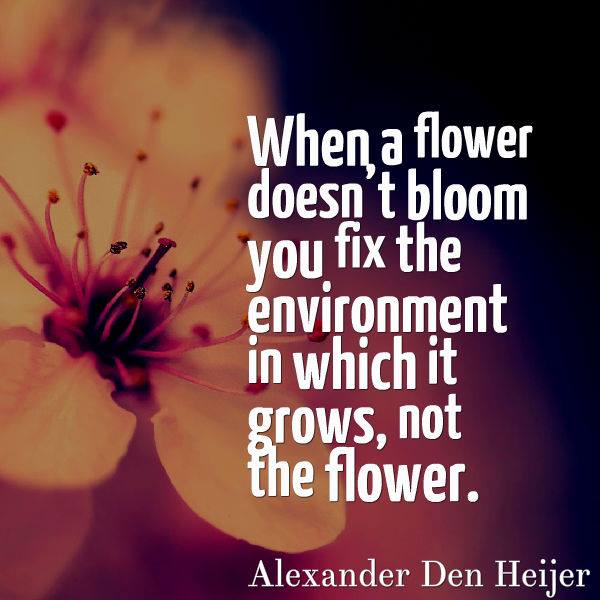WOW, what a powerful quote.... how often do we try to fix the flower? How often do we expect the flower to grow, and change and thrive to meet our 'standards'? How often do we neglect to 'fix the environment'?
What does this mean for me in my inquiry?
I must focus on the growth and needs of my individual flowers...
I must fix the environment...
I must make changes to meet the needs of all my individual flowers...
Changes around the push and pull factor are a constant challenge... a constant area of reflection for me.
Am I being too nurturing, too protecting?
Do I need to take the frost cloth off to allow hardening off?
Do I need to allow the frost cloth on for longer to allow for greater protection from the elements.
How do I allow the flowers to cross pollinate?
What is my role in pruning the dead wood?
What is my role in allowing the flower to reflect on it's beauty, and growth and purpose?
What a wonderful Saturday morning quote to really get me thinking...
Would love to hear your thoughts on 'fixing the environment, not the flower'....

Love, love, LOVE this Anne! Your questions have got me thinking as well... We have taken Sir Ken's quote "creating a climate of possibilty" (with his permission) for our vision. This metaphor you share really resonates to me... I will have to use this one with the team! Thanks!
ReplyDeleteHiya Claire,
DeleteThanks so much for the comment. I have spent time this weekend thinking through this quote! It really resonates in so many ways! At the end of the day today I was planting my sweet peas in pots around an arch way I want them to grow around. I thought lots about the environment... and I look forward to many sweet fragrant blooms... I also put in a lot of support, in the form of potting mix full of nutrients, watered them in well and added structures to support their growth... the more I think about the quote the more it intrigues me... Looking forward to unpacking it further and would love to see what you come up with as well.
I love your "creating a climate of possibility"... and I hope I have done this for my sweet peas! Now to do so for my 'flowers' this week...
Thanks
Anne K
I guess my only question is - do your sweet peas (my favourite/ childhood blooms) have a desire/ need to grow around that arch... How much of your plan is plant led? ;)
DeleteOooh Claire, what a great question! And by the way, I am loving the conversation and challenge...
Deletehttps://en.wikipedia.org/wiki/Sweet_pea
So, I guess a sweet pea's desire is to scramble up support, and bloom...
"They are grown up canes, with the new shoots being regularly pinched out to promote a bushy habit and higher flower yields." To align this with learning, what do we 'pinch out' regularly?
"the flowers appearing in midsummer and continuing for many weeks if regularly deadheaded." When do we dead head?
"They are grown up canes", we provide the support we know they need....
I love the fragrance and the colours. This year, unusually for me, I have gone with black, white and white with a black fringe for the colours of my sweet peas. I only hope their fragrance is strong because I grow them for their fragrance as much as their looks.
"The plant led' part of my plan is for them to flourish in an environment that meets their needs....
I feel a second blog post coming on....
AK :-)
Just saying.... I Love that even more - "...scramble up support and bloom!"
DeleteI am really looking forward to that next post as I am really enjoying the possibilities that come from this metaphor!
:)
Great quote - we need to remember this every single day!
ReplyDeleteHi Jo,
DeleteThanks for the comment! Indeed we do need to remember this everyday. Just as each plant or flower needs it's own unique 'environment' to flourish, so do our learners. From the mix, to companion planting, to weeding, pruning, watering.... there are many great analogies here to explore.... As winter end, and spring begins, our learners, just like our flowers, move into a new season, with new possibilities, new sprouts and shoots, and colours...
Thanks
Anne K
I love this! I saw this on FB and this resonates with me as well. I love to garden and this spoke to me so loudly and clearly on how I felt my SPD daughter was being judged and responding to behavioral techniques used in the classroom that scared her. At home we saw a happy, energetic, curious, joyful child. The school saw one that was withdrawn and scared. They labeled her erroneously and jumped to conclusions about her without listening to what her needs were. In fact, they dismissed them. We can't be doing this to our children. The system can't be so rigid and they MUST listen to parents as the expert on their child! This quote is perfect and one I wish the school and all teachers would adopt as their philosophy!
ReplyDelete